| Route: Madrid, Toledo, Guadalupe,
Merida, Badajoz, Elvas, Reguendis de Monsaraz Aracena, Sevilla, Toledo,
Malaga, Almuñecar, Granada, Almuñecar, Salobreña,
Ronda |
| |
| 341. Wochenbericht 05.12.-13.12.2009
Route: Madrid, Toledo, Guadalupe, Merida
|
| |
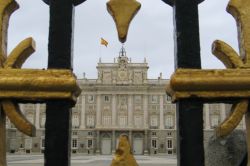 Madrid:
Though our plane landed at 1:30 p.m. we first had to wait 1,5
hours until we could pick up our bikes which we also had to reassemble
(we just hat two small boxes for our bikes and had to take of the
racks). It was already around sunset, when we finally have been ready,
and so we camped close to the airport behind a bush. Every road around
the airport is a freeway and so we haven't been allowed to cycle on
them and so we took the Metro in Downtown Madrid next morning. It's
December 6th and so the whole town is crowded, but we still enjoy
some sightseeing. Madrid:
Though our plane landed at 1:30 p.m. we first had to wait 1,5
hours until we could pick up our bikes which we also had to reassemble
(we just hat two small boxes for our bikes and had to take of the
racks). It was already around sunset, when we finally have been ready,
and so we camped close to the airport behind a bush. Every road around
the airport is a freeway and so we haven't been allowed to cycle on
them and so we took the Metro in Downtown Madrid next morning. It's
December 6th and so the whole town is crowded, but we still enjoy
some sightseeing.
|
| |
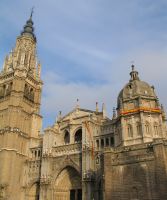 Toledo:
Toledo, sitting on a hill above Rio Tajo, is one of the most famous
tourist attractions in Spain. With its old churches and mosques, the
beautiful cobblestone alleys, the beautiful street cafes and last
but not least the cathedral, Toledo is quite an awesome place. We
stroll all day long through the alleys and enjoy the feeling of this
old town. Toledo:
Toledo, sitting on a hill above Rio Tajo, is one of the most famous
tourist attractions in Spain. With its old churches and mosques, the
beautiful cobblestone alleys, the beautiful street cafes and last
but not least the cathedral, Toledo is quite an awesome place. We
stroll all day long through the alleys and enjoy the feeling of this
old town.
|
| |
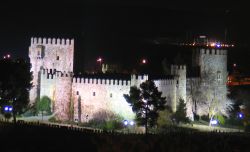 Sleeping
in a castle: In Toledo the Youth Hostel in inside of an old castle
and as we never slept in a castle on our trip we go for it. The lady
at the reception seems to like us and so we end up with a private
room with our own private bathroom. The photo, by the way, shows the
Youth Hostel at night. Sleeping
in a castle: In Toledo the Youth Hostel in inside of an old castle
and as we never slept in a castle on our trip we go for it. The lady
at the reception seems to like us and so we end up with a private
room with our own private bathroom. The photo, by the way, shows the
Youth Hostel at night.
|
| |
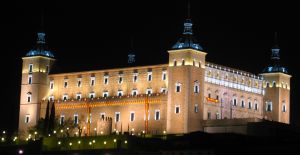 Toledo
at night: Of course Toledo is also illuminated at night, which
is especially cool and beautiful right now around Christmas. Toledo
at night: Of course Toledo is also illuminated at night, which
is especially cool and beautiful right now around Christmas.
|
| |
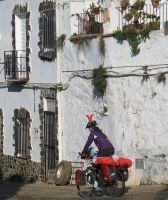 Rollercoaster:
Though we both have been already to Spain we didn't remember it to
be that hilly. Though frosty at night it's sunny and warm during the
day and so we really enjoy cycling through the countryside. Rollercoaster:
Though we both have been already to Spain we didn't remember it to
be that hilly. Though frosty at night it's sunny and warm during the
day and so we really enjoy cycling through the countryside.
|
| |
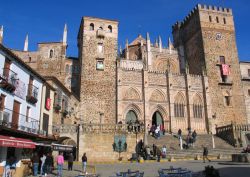 Guadalupe:
Guadalupe is a small town in the hills which boasts a huge monastery.
As the people here in the mountains tend not to open their mouth while
speaking and also seem to have a pretty strong accent I ask the lady
at the ticket office if the guides are speakig clear and not too fast.
"That depends on the guide" is her answer, and as she's
not willing to find out if the next guide speaks understandable I
decide not to visit the monastery. Guadalupe:
Guadalupe is a small town in the hills which boasts a huge monastery.
As the people here in the mountains tend not to open their mouth while
speaking and also seem to have a pretty strong accent I ask the lady
at the ticket office if the guides are speakig clear and not too fast.
"That depends on the guide" is her answer, and as she's
not willing to find out if the next guide speaks understandable I
decide not to visit the monastery. |
| |
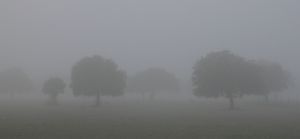 Fog:
After two sunny days suddenly fog moves in. First we still could
see the thousands of crane's, who stay here for the winter, but then
everything disappears. The fog gets so thick, that two policemen stop
us and tell us, that we would have to wear a bright yellow jacket
if the sight is that bad. As they are very very generous to us, they
still allow us to cycle into the next village (about 3 Km away), but
after 1 Km we leave the road and pitch our tent. Fog:
After two sunny days suddenly fog moves in. First we still could
see the thousands of crane's, who stay here for the winter, but then
everything disappears. The fog gets so thick, that two policemen stop
us and tell us, that we would have to wear a bright yellow jacket
if the sight is that bad. As they are very very generous to us, they
still allow us to cycle into the next village (about 3 Km away), but
after 1 Km we leave the road and pitch our tent. |
| |
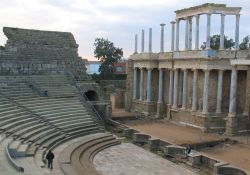 Merida:
During the Roman Empire Merida was the biggest Roman city in Spain
and so one can visit quit some old ruins. The theater and the amphitheater
(for the gladiator fights) were built 15 BC and 8 BC and were so big,
that they could hold 20.000 spectators. Merida:
During the Roman Empire Merida was the biggest Roman city in Spain
and so one can visit quit some old ruins. The theater and the amphitheater
(for the gladiator fights) were built 15 BC and 8 BC and were so big,
that they could hold 20.000 spectators. |
| |
|
342. Weekly Report 14.12.-20.12.2009
Route: Badajoz, Elvas, Reguendis de Monsaraz Aracena, Sevilla
|
| |
|
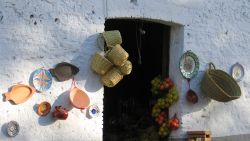 Short
visit in Portugal: To avoid a couple of mountains in Spain we
headed a bit to the west and cycled through Portugal. The people
have been very friendly, but communication was quite difficult,
as we speak no Portuguese and as they speak hardly any English or
Spanish. Unfortunately Portugal was not as flat as expected and
so we also have to clime quite some hills. Short
visit in Portugal: To avoid a couple of mountains in Spain we
headed a bit to the west and cycled through Portugal. The people
have been very friendly, but communication was quite difficult,
as we speak no Portuguese and as they speak hardly any English or
Spanish. Unfortunately Portugal was not as flat as expected and
so we also have to clime quite some hills.
|
| |
|
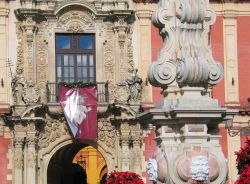 Sevilla:
Sevilla has quite a long and exciting history. Sevilla was already
an important trading center from the Phoenecians long before the
Romans conquerred the Iberian Penninsula. Later Sevilla was under
Muslem rule until they were reconquerred from the Spanish Christians.
Besides the huge Cathetral and the Alcázar, the muslim palace,
the narrow alleys in the Jenish quater with it´s small squares
and old houses are well worth the trip. Sevilla:
Sevilla has quite a long and exciting history. Sevilla was already
an important trading center from the Phoenecians long before the
Romans conquerred the Iberian Penninsula. Later Sevilla was under
Muslem rule until they were reconquerred from the Spanish Christians.
Besides the huge Cathetral and the Alcázar, the muslim palace,
the narrow alleys in the Jenish quater with it´s small squares
and old houses are well worth the trip.
|
| |
| 343. Weekly Report 21.12.-27.12.2009
Route: Seville, Toledo, Malaga, Almuñecar, Granada
|
| |
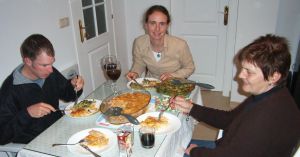 Winter
storms: Spain is supposed to have plenty of sunshine, but unfortunately
we hit a quite unusual period of rain and storms. As soon as we left
Seville it started pouring and the wind became so strong and loud
that we slept with earplugs. As we're cycling through the mountains
we change our direction quite frequently and so we even get some tailwind
once in a while. Unfortunately its raining so heavy, that we're wet
to the bones when we arrived in Almuñecar. Winter
storms: Spain is supposed to have plenty of sunshine, but unfortunately
we hit a quite unusual period of rain and storms. As soon as we left
Seville it started pouring and the wind became so strong and loud
that we slept with earplugs. As we're cycling through the mountains
we change our direction quite frequently and so we even get some tailwind
once in a while. Unfortunately its raining so heavy, that we're wet
to the bones when we arrived in Almuñecar. |
| |
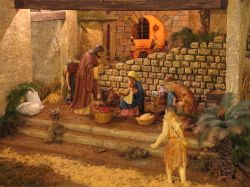 Christmas:
We spent a lovely family Christmas with Nadine's mum and her husband
Uwe. It's pouring and we are really happy to stay inside the holiday
apartment. As we haven't seen each other for quite a long time there
are of course a lot of stories to tell and so it's not really boring.
Uwes and Martins mum sent us some homebaked Christmas cookies. what
a treat! Christmas:
We spent a lovely family Christmas with Nadine's mum and her husband
Uwe. It's pouring and we are really happy to stay inside the holiday
apartment. As we haven't seen each other for quite a long time there
are of course a lot of stories to tell and so it's not really boring.
Uwes and Martins mum sent us some homebaked Christmas cookies. what
a treat!
|
| |
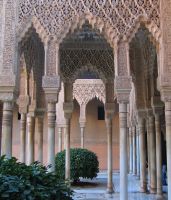 Alhambra:
Of course we also set out for some sightseeing. The chosen object:
The Alhambra in Malaga. Having challenged the chaotic traffic in downtown
Granada strolling through the Alhambra was quite a pleasure. Granada
was the Muslim capital for 800 years, and therefor the Alhambra became
one of the most important and beautiful Muslim buildings in the world.
The head of the Alhambra is the Nazarid palace with its palacios,
stuccos and woodworks. But also the gardens with its fountains, watercanals
and artificial lakes are pretty impressive. Alhambra:
Of course we also set out for some sightseeing. The chosen object:
The Alhambra in Malaga. Having challenged the chaotic traffic in downtown
Granada strolling through the Alhambra was quite a pleasure. Granada
was the Muslim capital for 800 years, and therefor the Alhambra became
one of the most important and beautiful Muslim buildings in the world.
The head of the Alhambra is the Nazarid palace with its palacios,
stuccos and woodworks. But also the gardens with its fountains, watercanals
and artificial lakes are pretty impressive.
|
| |
| 344. Weekly Report 28.12.-03.01.2010
Route: Almuñecar, Salobreña, Ronda
|
| |
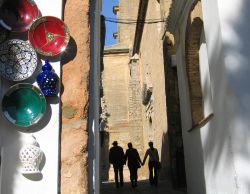 Salobreña:
The old town of Salobreña sits on top of a hill right on the
coast. Though the hill didn't look that big, we were quite puffing
while climbing through the narrow and steep alleys and therefor had
to recover in a beautiful small cafe. Salobreña:
The old town of Salobreña sits on top of a hill right on the
coast. Though the hill didn't look that big, we were quite puffing
while climbing through the narrow and steep alleys and therefor had
to recover in a beautiful small cafe.
|
| |
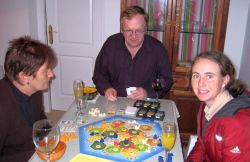 New
Years Eve: We've been a bit afraid that we would fall asleep long
before midnight and started to play the boardgame Settlers of Catan.
Suddenly time started running and before long we could welcome the
new year. New
Years Eve: We've been a bit afraid that we would fall asleep long
before midnight and started to play the boardgame Settlers of Catan.
Suddenly time started running and before long we could welcome the
new year.
|
| |
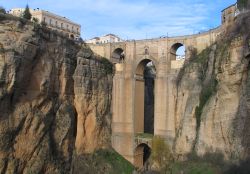 Ronda:
Now wonder, that Ronda, with it's location high above the El Tajo
gorge is the pueblo blanco (white village) with the most dramatic
location in Andalucia. A total of 3 bridges over the El Tajo River
into the old Muslim town. The new bridge was built in the 18th century
and is therefor not really new any more. We explore the old town with
it's narrow alleys and enjoy the warm sun and the great viewpoints. Ronda:
Now wonder, that Ronda, with it's location high above the El Tajo
gorge is the pueblo blanco (white village) with the most dramatic
location in Andalucia. A total of 3 bridges over the El Tajo River
into the old Muslim town. The new bridge was built in the 18th century
and is therefor not really new any more. We explore the old town with
it's narrow alleys and enjoy the warm sun and the great viewpoints.
|
| |
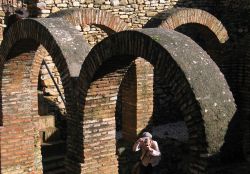 Baños
Arabes: The old Arabic bathhouse is locate right next to the eldest
of the three bridges. At that time this bridge was the only on and
so everyone who entered the town could first was down all the dust
from the road. The water for the baths was pumped up with a waterwheel
turned by a donkey. Then the water was heated up from a huge oven
and later on distributed into the pools inside the bath. The hot air
from the oven was used to heat up the floor from underneath. Unfortunately
not much is left from the beautiful old bathhouse. Baños
Arabes: The old Arabic bathhouse is locate right next to the eldest
of the three bridges. At that time this bridge was the only on and
so everyone who entered the town could first was down all the dust
from the road. The water for the baths was pumped up with a waterwheel
turned by a donkey. Then the water was heated up from a huge oven
and later on distributed into the pools inside the bath. The hot air
from the oven was used to heat up the floor from underneath. Unfortunately
not much is left from the beautiful old bathhouse. |
| |
| |
